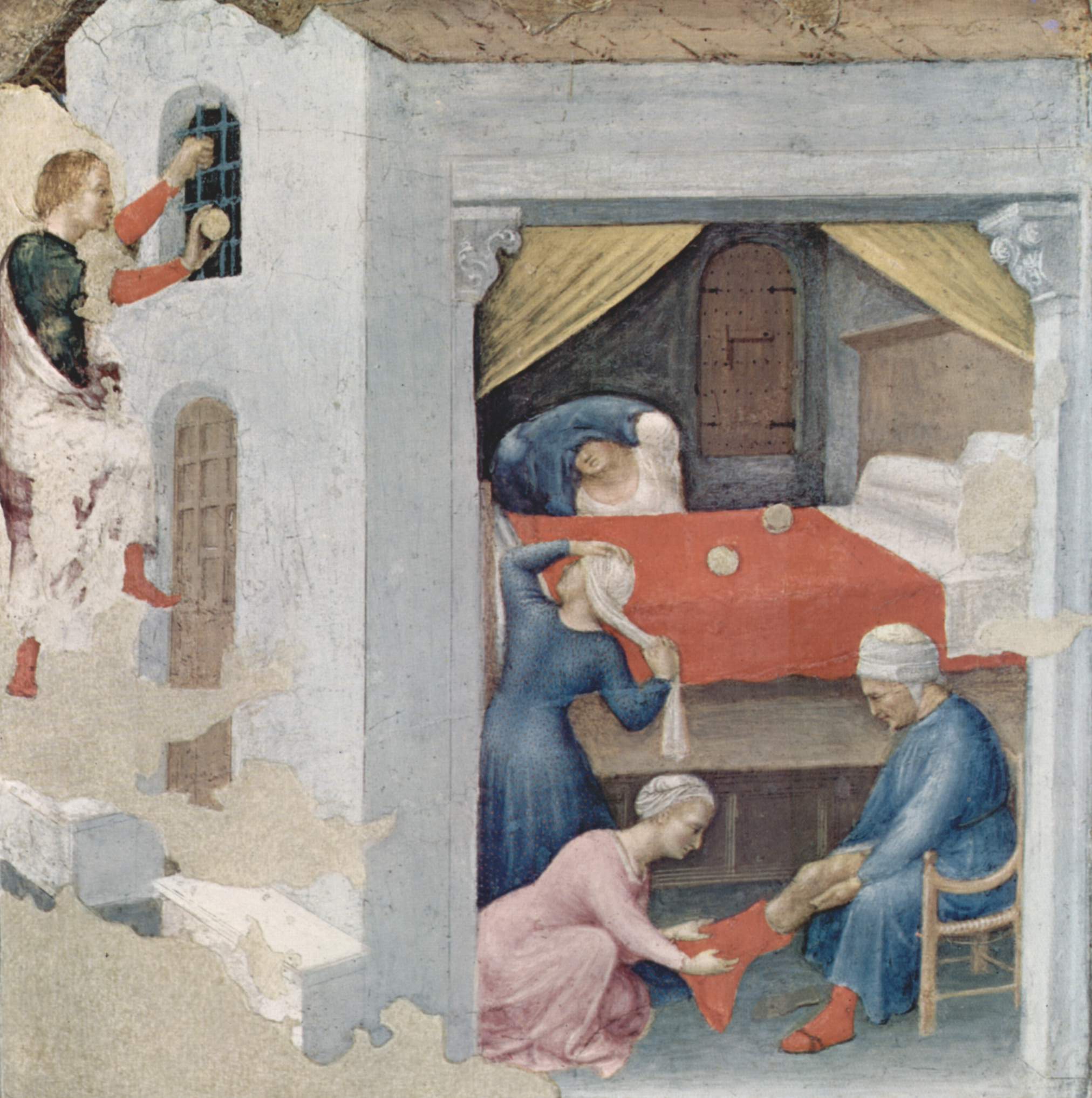Santa Claus—otherwise known as Saint Nicholas or Kris Kringle—has a long history steeped in Christmas traditions. He became famous for working miracles and helping the needy. In the 5th century, the Roman Emperor Theodosius II built a church in his honor.
It is believed that Nicholas was born sometime around A.D. 280 in Patara, near Myra in modern-day Turkey. Much admired for his piety and kindness, St. Nicholas became the subject of many legends. It is said that he gave away all of his inherited wealth and traveled the countryside helping the poor and sick.
One story tells how St Nicholas saved three young women from being forced into prostitution by dropping bags of gold through the windows of their house so that their father could afford a dowry to have them married.

And there’s another story about a terrible famine, where a butcher captured and killed three young children, planning to sell them off as meat. St Nicholas found the children, pickling in a barrel, and brought them back to life.
Every Christian saint has a feast day. In St Nicholas’ case, it was 6th December. This was traditionally considered a lucky day to make large purchases or to get married. The celebration of his day in the early Christian church was unlike what it is now but that’s where the earliest traces of Santa Claus originate, in a gift-giving bishop from Turkey.
Over the course of many years, Nicholas’s popularity spread and he became known as the protector of children and sailors. By the Renaissance, St. Nicholas was the most popular saint in Europe. Even after the Protestant Reformation, when the veneration of saints began to be discouraged, St. Nicholas maintained a positive reputation, especially in Holland.
It was the Christianisation of pagan Europe and the merging of religious cultures which helped create the figure we know today. In Germanic paganism, there was a midwinter festival called Yuletide which involved drinking, eating, and haunted nights.
Yuletide was also associated with the Wild Hunt of Odin, a ride through the night-time sky of ghosts, valkyries, and other creatures led by Odin or some other mythological figure. It may be in this that Santa Claus riding reindeer through the sky originates.
So how did the day of gift-giving and marriage move to the 25th of December, the day of Jesus’ birth and one essentially unrelated to Saint Nicholas?
In the 1500s, as Protestantism rose and Catholic ways were cast off, Martin Luther moved celebrations associated with the 6th of December to the 25th of December. He disapproved of the Catholic veneration of saints and thought Christ’s birth was a more appropriate date.
The same occurred in England, where Yuletide had also become Christmas and the celebrations associated with the Feast of St Nicholas moved to the 25th of December. However, in Europe, it was the allegorical, paganistic figure of “Father Christmas” who had merged with Saint Nicholas.
And also another key part of this story is the Medieval culture of feasting and merrymaking. In the Middle Ages feast days – whether celebrating saints or anything else – were important occasions where special foods were eaten and people drank plentifully.
But down the centuries Christmas was a controversial celebration. Its use of pagan traditions and extravagant, licentious celebrations involving mass drunkenness caused it to be banned in many countries at many different times.
After the English Civil War in the 17th century, the new Puritan regime under Oliver Cromwell banned Christmas for all those reasons. After their fall Christmas was reinstated, and Father Christmas became even more closely associated with feasting and merrymaking.
This version of the figure is best known from Charles Dicken’s A Christmas Carol, during the Victorian revival of Christmas, as an old and jolly man with a big belly who symbolized merrymaking. But it was from the USA that the modern Santa Claus would re-enter Europe.
Saint Nicholas made his first inroads into American popular culture towards the end of the 18th century. In December 1773, and again in 1774, a New York newspaper reported that groups of Dutch families had gathered to honor the anniversary of his death.
The name Santa Claus evolved from Saint Nicholas’ Dutch nickname, Sinter Klaas, a shortened form of Sint Nikolaas (Dutch for Saint Nicholas). In 1804, John Pintard, a member of the New York Historical Society, distributed woodcuts of St. Nicholas at the society’s annual meeting. The background of the engraving contains now-familiar Santa images including stockings filled with toys and fruit hung over a fireplace.
The many different pagans and Christian traditions of Europe were consolidated in America into a single figure. New things were formulated in the USA, too. Santa’s helpers – the elves – seemingly came from the tomtenisse of Scandinavian folklore.
Judging from this history of Santa Claus, it is absolute ignorance for Christians to continue to speak against the figure now known as Santa Claus as all that’s good about him came from a Christian monk. It is important Christians own Santa and begin to take control of the commercial aspects of him that control the movies, imagery, and other narratives associated with the figure.